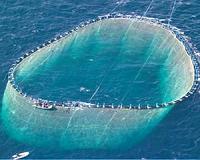| . |  |
. |
Providence RI (SPX) Nov 18, 2010 One of biggest factors promoting the diversity of coastal ocean life is how fast the water flows, according to new research by ecologists at Brown University. Experiments and observation in Palau, Alaska, and Maine showed that the faster the flow, the greater the number of invertebrate species that live on rocks under the water. The findings, published the week of Nov. 15 in the journal Ecology Letters, could help improve management of delicate and complex coastal ecosystems, said James Palardy, a former Brown doctoral student and the paper's lead author. Finding the fastest water could point scientists to areas where diversity is likely greatest - and perhaps especially worthy of protection - and to zones where invasive species could establish their first beachheads. Jon Witman, professor of ecology and environmental biology and Palardy's co-author on the paper, said the results were clear and consistent at all three regions, including in Maine and Alaska where they experimentally manipulated water flow speed. "It totally blew us a way that we got almost identical results in two marine regions of the world separated by 4,000 miles with completely different regional diversities, and no species shared in common," Witman said. "It's a wake-up call saying that water flow is a really strong predictor of how many species are present in a particular area of the ocean." The reason why faster flow seems to promote diversity, Witman said, is that it allows for the larvae of rock-dwelling invertebrates, such as barnacles, sea squirts, corals and sponges, to spread farther. Although the environments are quite different, it's somewhat analogous to how trees and flowers can disperse their seeds farther in a stiff wind.
Novel experiment The pair's goal was to speed up water flow without resorting to expensive and short-lived battery-powered pumps. Instead, the ecologists relied on simple physics that require a volume of water to flow faster when it moves through a narrowed space. Based on prototypes developed in a giant flume in the basement of the BioMed research building at Brown, they built channels about 7 feet long and about 18 inches high. They lined the walls with plates where organisms could latch on and grow. The test channels narrowed to about half their width in the middle, taking on a bow tie shape. The control channels remained the same width throughout. The control and test channels were placed about 3 to 6 feet below the lowest tide in each of two sites in Maine and Alaskan coastal waters. In every case they found that the number of different species on the plates in the test channels was much higher than on the plates in the control channels. The greater diversity was no flash in the pan, either. The pattern was visible from early stages and persisted for more than a year of study. Witman also surveyed natural areas in Palau, and Palardy and Witman did the same in Alaska, finding similar effects in areas with faster flow. Witman said his hope is that the work will not just explain greater biodiversity but will help stem the tide of its loss. "There's a global biodiversity crisis where we're losing species," he said. "Ecology is very much concerned with sustaining natural processes." Funding for the research came from the National Oceanographic and Atmospheric Administration, the National Science Foundation, and Abt Associates Inc., a Cambridge, Mass., and Washington, D.C.-based consulting firm where Palardy now works as a senior environmental analyst.
Share This Article With Planet Earth
Related Links Brown University Water News - Science, Technology and Politics
 Widely Adopted Indicator Of Fisheries Health Questioned
Widely Adopted Indicator Of Fisheries Health QuestionedWashington DC (SPX) Nov 18, 2010 The most widely adopted measure for assessing the state of the world's oceans and fisheries led to inaccurate conclusions in nearly half the ecosystems where it was applied. The new analysis was performed by an international team of fisheries scientists, and is reported in this week's issue of the journal Nature. "Applied to individual ecosystems it's like flipping a coin; half the t ... read more |
|
| The content herein, unless otherwise known to be public domain, are Copyright 1995-2010 - SpaceDaily. AFP and UPI Wire Stories are copyright Agence France-Presse and United Press International. ESA Portal Reports are copyright European Space Agency. All NASA sourced material is public domain. Additional copyrights may apply in whole or part to other bona fide parties. Advertising does not imply endorsement,agreement or approval of any opinions, statements or information provided by SpaceDaily on any Web page published or hosted by SpaceDaily. Privacy Statement |